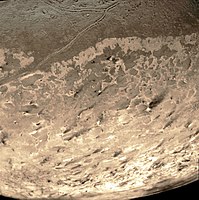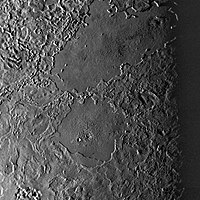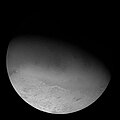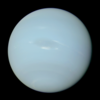Triton (moon)
 From Wikipedia - Reading time: 32 min
From Wikipedia - Reading time: 32 min
 A black-and-white mosaic of Triton, constructed from Voyager 2 imagery. Triton's massive south polar cap dominates most of the image, with cryovolcanic features such as Leviathan Patera located left of center | |
| Discovery | |
|---|---|
| Discovered by | William Lassell |
| Discovery date | October 10, 1846 |
| Designations | |
Designation | Neptune I |
| Pronunciation | /ˈtraɪtən/ (TRY-tən) |
Named after | Τρίτων Trītōn |
| Adjectives | Tritonian (/traɪˈtoʊniən/)[1] |
| Orbital characteristics | |
| 354,759 km | |
| Eccentricity | 0.000016[2] |
| 5.876854 d (retrograde)[2][3] | |
Average orbital speed | 4.39 km/s[a] |
| Inclination | 129.812° (to the ecliptic) 156.885° (to Neptune's equator)[4][5] 129.608° (to Neptune's orbit) |
| Satellite of | Neptune |
| Physical characteristics | |
| 1,353.4±0.9 km[6] (0.2122 R🜨) | |
| 23,018,000 km2[b] | |
| Volume | 10,384,000,000 km3[c] |
| Mass | (2.1389±0.0028)×1022 kg (0.00358 Earths)[5] |
Mean density | 2.061 g/cm3[6] |
| 0.779 m/s2 (0.0794 g) (0.48 Moons)[d] | |
| 1.455 km/s[e] | |
| synchronous | |
| 5 d, 21 h, 2 min, 53 s[7] | |
| 0° (to orbit about Neptune)[f] | |
| Albedo | 0.76[6] |
| Temperature | 38 K (−235.2 °C)[7] |
| 13.47[8] | |
| −1.2[9] | |
| Atmosphere | |
Surface pressure | 1.4 Pa (1.38×10−5 atm) (1989)[7] 1.9 Pa (1.88×10−5 atm) (1997)[10] 1.454 Pa (1.43×10−5 atm) (2022)[11] |
| Composition by volume | nitrogen; methane and carbon monoxide traces[12] |
Triton is the largest natural satellite of the planet Neptune. It is the only moon of Neptune massive enough to be rounded under its own gravity and hosts a thin, hazy atmosphere. Triton orbits Neptune in a retrograde orbit—revolving in the opposite direction to the parent planet's rotation—the only large moon in the Solar System to do so.[3][13] Triton is thought to have once been a dwarf planet from the Kuiper belt, captured into Neptune's orbit by the latter's gravity.[14]
At 2,710 kilometers (1,680 mi)[6] in diameter, Triton is the seventh-largest moon in the Solar System, the second-largest planetary moon in relation to its primary (after Earth's Moon), and larger than all of the known dwarf planets. The mean density is 2.061 g/cm3,[6] reflecting a composition of approximately 30–45% water ice by mass,[7]: 866 with the rest being mostly rock and metal. Triton is differentiated, with a crust of primarily ice atop a probable subsurface ocean of liquid water and a solid rocky-metallic core at its center. Although Triton's orbit is nearly circular with a very low orbital eccentricity of 0.000016,[2] Triton's interior may still experience tidal heating through obliquity tides.
Triton is one of the most geologically active worlds in the Solar System, with an estimated average surface age of less than 100 million years old. Its surface is covered by frozen nitrogen and is geologically young, with very few impact craters. Young, intricate cryovolcanic and tectonic terrains suggest a complex geological history. The atmosphere of Triton is composed primarily of nitrogen, with minor components of methane and carbon monoxide. Triton's atmosphere is relatively thin and strongly variable, with its atmospheric surface pressure varying by up to a factor of three within the past 30 years. Triton's atmosphere supports clouds of nitrogen ice crystals and a layer of organic atmospheric haze.
Triton was the first Neptunian moon to be discovered, on October 10, 1846, by English astronomer William Lassell. The 1989 flyby of Triton by the Voyager 2 spacecraft remains the only up-close visit to the moon as of 2025. As the probe was only able to study about 40% of the moon's surface, multiple concept missions have been developed to revisit Triton. These include a Discovery-class Trident and New Frontiers-class Triton Ocean Worlds Surveyor and Nautilus.[15][16]
Discovery and naming
[edit]
Triton was discovered by British astronomer William Lassell on October 10, 1846,[17] just 17 days after the discovery of Neptune. When John Herschel received news of Neptune's discovery, he wrote to Lassell suggesting he search for possible moons. Lassell discovered Triton eight days later.[17][18] Lassell also claimed for a period[g] to have discovered rings.[19] Although Neptune was later confirmed to have rings, they are so faint and dark that it is not plausible he saw them. A brewer by trade, Lassell spotted Triton with his self-built 61 cm (24 in) aperture metal mirror reflecting telescope (also known as the "two-foot" reflector).[20] This telescope was donated to the Royal Observatory, Greenwich in the 1880s, but was eventually dismantled.[20]
Triton is named after the Greek sea god Triton (Τρίτων), the son of Poseidon (the Greek god corresponding to the Roman Neptune). The name was first proposed by Camille Flammarion in his 1880 book Astronomie Populaire,[21] and was officially adopted many decades later.[22] Until the discovery of the second moon Nereid in 1949, Triton was commonly referred to as "the satellite of Neptune". Lassell did not name his discovery; he later successfully suggested the name Hyperion for the eighth moon of Saturn when he discovered it.[23]
Orbit and rotation
[edit]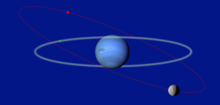
Triton is unique among all large moons in the Solar System for its retrograde orbit around its planet (i.e. it orbits in a direction opposite to the planet's rotation). Most of the outer irregular moons of Jupiter and Saturn also have retrograde orbits, as do some of the irregular moons of Uranus and Neptune. However, these moons are all much more distant from their primaries and are small in comparison, with the largest of them (Phoebe)[h] having only 8% of the diameter (and 0.03% of the mass) of Triton.
Triton's orbit is associated with two tilts, the obliquity of Neptune's rotation to Neptune's orbit, 30°, and the inclination of Triton's orbit to Neptune's rotation, 157° (an inclination over 90° indicates retrograde motion). Triton's orbit precesses forward relative to Neptune's rotation with a period of about 678 Earth years (4.1 Neptunian years),[4][5] making its Neptune-orbit-relative inclination vary between 127° and 173°. That inclination is currently 130°; Triton's orbit is now near its maximum departure from coplanarity with Neptune's.
Triton's rotation is tidally locked to be synchronous with its orbit around Neptune: it keeps one face oriented toward the planet at all times. Its equator is almost exactly aligned with its orbital plane.[24] At present, Triton's rotational axis is about 40° from Neptune's orbital plane, hence as Neptune orbits the Sun, Triton's polar regions take turns facing the Sun, resulting in seasonal changes as one pole, then the other moves into the sunlight. Such changes were observed in 2010.[25]
Triton's revolution around Neptune has become a nearly perfect circle with an eccentricity of almost zero. Viscoelastic damping from tides alone is not thought to be capable of circularizing Triton's orbit in the time since the origin of the system, and gas drag from a prograde debris disc is likely to have played a substantial role.[4][5] Tidal interactions also cause Triton's orbit, which is already closer to Neptune than the Moon is to Earth, to gradually decay further; predictions are that 3.6 billion years from now, Triton will pass within Neptune's Roche limit.[26] This will result in either a collision with Neptune's atmosphere or the breakup of Triton, forming a new ring system similar to that found around Saturn.[26]
Capture
[edit]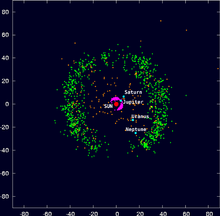
The current understanding of moons in retrograde orbits means they cannot form in the same region of the solar nebula as the planets they orbit. Therefore Triton must have been captured from elsewhere in the Solar System. Astrophysicists believe it might have originated in the Kuiper belt,[14] a ring of small icy objects extending from just inside the orbit of Neptune to about 50 AU from the Sun. Thought to be the point of origin for the majority of short-period comets observed from Earth, the belt is also home to several large, planet-like bodies including Pluto, which is now recognized as the largest in a population of Kuiper belt objects (the plutinos) locked in resonant orbits with Neptune. Triton is only slightly larger than Pluto and is nearly identical in composition, which has led to the hypothesis that the two share a common origin.[27]
This has been further supported in a 2024 study of the chemical composition of Pluto and Triton which suggests they originated in the same region of the outer Solar System before the latter was pulled into Neptune’s orbit. Kathleen Mandt at NASA's Goddard Space Flight Center in Maryland and her colleagues hypothesize that Triton and Pluto formed close to each other before the Solar System settled down. "They probably formed in the same region, which wouldn't be where the Kuiper belt is now—it would have been either closer or further away," says Mandt.[28]
Studying prior data on the two bodies, the team found that both have a large amount of nitrogen and trace amounts of methane and carbon monoxide, which could have accumulated in the outer regions of the young nebula "For some reason, Triton was then ejected from this region and ensnared by Neptune". "They had to have formed beyond the water-ice line," says Mandt, referring to the distance from the sun where water would freeze into ice or snow, which is why Triton and Pluto have similar amounts of certain key elements. "One possibility is that the giant planets moved closer to the sun early in the first 100 million years or so of the Solar System, which may have disrupted the orbits of some bodies like Triton.", says Mandt.[28]
The proposed capture of Triton may explain several features of the Neptunian system, including the extremely eccentric orbit of Neptune's moon Nereid and the scarcity of moons as compared to the other giant planets. Triton's initially eccentric orbit would have intersected the orbits of irregular moons and disrupted those of smaller regular moons, dispersing them through gravitational interactions.[4][5]
Triton's eccentric post-capture orbit would have also resulted in tidal heating of its interior, which could have kept Triton fluid for a billion years; this inference is supported by evidence of differentiation in Triton's interior. This source of internal heat disappeared following tidal locking and circularization of the orbit.[29]
Two types of mechanisms have been proposed for Triton's capture. To be gravitationally captured by a planet, a passing body must lose sufficient energy to be slowed down to a speed less than that required to escape.[7] An early model of how Triton may have been slowed was by collision with another object, either one that happened to be passing by Neptune (which is unlikely), or a moon or proto-moon in orbit around Neptune (which is more likely).[7] A more recent hypothesis suggests that, before its capture, Triton was part of a binary system. When this binary encountered Neptune, it interacted in such a way that the binary dissociated, with one portion of the binary expelled, and the other, Triton, becoming bound to Neptune. This event is more likely for more massive companions.[14] This hypothesis is supported by several lines of evidence, including binaries being very common among the large Kuiper belt objects.[30][31] The event was brief but gentle, saving Triton from collisional disruption. Events like this may have been common during the formation of Neptune, or later when it migrated outward.[14]
However, simulations in 2017 showed that after Triton's capture, and before its orbital eccentricity decreased, it probably did collide with at least one other moon, and caused collisions between other moons.[32][33]
Physical characteristics
[edit]Triton is the seventh-largest moon and sixteenth-largest object in the Solar System and is modestly larger than the dwarf planets Pluto and Eris. It is also the largest retrograde moon in the Solar System. It accounts for more than 99.5% of all the mass known to orbit Neptune, including the planet's rings and fifteen other known moons,[i] and is also more massive than all known moons in the Solar System smaller than itself combined.[j] Also, with a diameter 5.5% that of Neptune, it is the largest moon of a gas giant relative to its planet in terms of diameter, although Titan is bigger relative to Saturn in terms of mass (the ratio of Triton's mass to that of Neptune is approximately 1:4788). It has a radius, density (2.061 g/cm3), temperature, and chemical composition similar to that of Pluto.[34]
Triton's surface is covered with a transparent layer of annealed frozen nitrogen. Only 40% of Triton's surface has been observed and studied, but it may be entirely covered in such a thin sheet of nitrogen ice. Triton's surface consists of 55% nitrogen ice with other ices mixed in. Water ice comprises 15–35% and frozen carbon dioxide (dry ice) the remaining 10–20%. Trace ices include 0.1% methane and 0.05% carbon monoxide.[7]: 868 There could also be ammonia ice on the surface, as there are indications of ammonia dihydrate in the lithosphere.[35] Triton's mean density implies that it probably consists of about 30–45% water ice (including relatively small amounts of volatile ices), with the remainder being rocky material.[7] Triton's surface area is 23 million km2, which is 4.5% of Earth, or 15.5% of Earth's land area. Triton has an unusually high albedo, reflecting 60–95% of the sunlight that reaches it, and it has changed only slightly since the first observations. By comparison, the Moon reflects only 11%.[36] This high albedo causes Triton to reflect a lot of whatever little sunlight there is instead of absorbing it,[37][38] causing it to have the coldest recorded temperature in the Solar System at 38 K (−235 °C).[39][40] Triton's reddish color is thought to be the result of methane ice, which is converted to tholins under exposure to ultraviolet radiation.[7][41]
Because Triton's surface indicates a long history of melting, models of its interior posit that Triton is differentiated, like Earth, into a solid core, a mantle and a crust. Water, the most abundant volatile in the Solar System, comprises Triton's mantle, enveloping a core of rock and metal. There is enough rock in Triton's interior for radioactive decay to maintain a liquid subsurface ocean to this day, similar to what is thought to exist beneath the surface of Europa and several other icy outer Solar System worlds.[7][42][43][44] This is not thought to be adequate to power convection in Triton's icy crust. However, the strong obliquity tides are believed to generate enough additional heat to accomplish this and produce the observed signs of recent surface geological activity.[44] The black material ejected is suspected to contain organic compounds,[43] and if liquid water is present on Triton, it has been speculated that this could make it habitable for some form of life.[43][45][46]
Atmosphere
[edit]
Triton has a tenuous but well-structured and global nitrogen atmosphere,[47] with trace amounts of carbon monoxide and small amounts of methane near its surface.[48][49][12] Like Pluto's atmosphere, the atmosphere of Triton is thought to result from the evaporation of nitrogen from its surface.[27] Its surface temperature is at least 35.6 K (−237.6 °C) because Triton's nitrogen ice is in the warmer, hexagonal crystalline state, and the phase transition between hexagonal and cubic nitrogen ice occurs at that temperature.[50] An upper limit in the low 40s (K) can be set from vapor pressure equilibrium with nitrogen gas in Triton's atmosphere.[51] This is colder than Pluto's average equilibrium temperature of 44 K (−229.2 °C). Triton's surface atmospheric pressure is only about 1.4–1.9 Pa (0.014–0.019 mbar).[7]

Turbulence at Triton's surface creates a troposphere (a "weather region") rising to an altitude of 8 km. Streaks on Triton's surface left by geyser plumes suggest that the troposphere is driven by seasonal winds capable of moving material over a micrometer in size.[52] Unlike other atmospheres, Triton's lacks a stratosphere and instead has a thermosphere from altitudes of 8 to 950 km and an exosphere above that.[7] The temperature of Triton's upper atmosphere, at 95±5 K, is higher than that at its surface, due to heat absorbed from solar radiation and Neptune's magnetosphere.[48][53] A haze permeates most of Triton's troposphere, thought to be composed largely of hydrocarbons and nitriles created by the action of sunlight on methane. Triton's atmosphere also has clouds of condensed nitrogen that lie between 1 and 3 km from its surface.[7]
In 1997, observations from Earth were made of Triton's limb as it passed in front of stars. These observations indicated a denser atmosphere than was deduced from Voyager 2 data.[54] Other observations have shown an increase in temperature by 5% from 1989 to 1998.[55] These observations indicated Triton was approaching an unusually warm southern hemisphere summer season that happens only once every few hundred years. Hypotheses for this warming include a change of frost patterns on Triton's surface and a change in ice albedo, which would allow more heat to be absorbed.[56] Another hypothesis argues that temperature changes are a result of the deposition of dark, red material from geological processes. Because Triton's Bond albedo is among the highest in the Solar System, it is sensitive to small variations in spectral albedo.[57] Based on the increase in atmospheric pressure between 1989 and 1997, it is estimated that by 2010 Triton's atmospheric pressure may have increased to as much as 4 Pa.[12] By 2017, however, Triton's atmospheric surface pressure had nearly returned to Voyager 2 levels; the cause for the rapid spike in atmospheric pressure between 1989 and 2017 remains unexplained.[11]
Surface features
[edit]
All detailed knowledge of the surface of Triton was acquired from a distance of 40,000 km by the Voyager 2 spacecraft during a single encounter in 1989.[58] The 40% of Triton's surface imaged by Voyager 2 revealed blocky outcrops, ridges, troughs, furrows, hollows, plateaus, icy plains, and a few craters. Triton is relatively flat; its observed topography never varies beyond a kilometer.[7] The impact craters observed are concentrated almost entirely in Triton's leading hemisphere.[59] Analysis of crater density and distribution has suggested that in geological terms, Triton's surface is extremely young, with regions varying from an estimated 50 million years old to just an estimated 6 million years old.[60] Fifty-five percent of Triton's surface is covered with frozen nitrogen, with water ice comprising 15–35% and frozen CO2 forming the remaining 10–20%.[61] The surface also has deposits of tholins, a dark, tarry slurry of various organic chemical compounds.[62]
Cryovolcanism
[edit]One of the largest cryovolcanic features found on Triton is Leviathan Patera,[63] a caldera-like feature roughly 100 km in diameter seen near the equator. Surrounding this caldera is a massive cryovolcanic plain, Cipango Planum, which is at least 490,000 km2 in area; assuming Leviathan Patera is the primary vent, Leviathan Patera is one of the largest volcanic or cryovolcanic constructs in the Solar System.[64] This feature is also connected to two enormous cryolava lakes seen northwest of the caldera. Because the cryolava on Triton is believed to be primarily water ice with some ammonia, these lakes would qualify as stable bodies of surface liquid water while they were molten. This is the first place such bodies have been found apart from Earth, and Triton is the only icy body known to feature cryolava lakes,[65] although similar cryomagmatic extrusions can be seen on Ariel, Ganymede, Charon, and Titan.[66]
Plumes
[edit]The Voyager 2 probe in 1989 observed a handful of geyser-like eruptions of nitrogen gas or water and entrained dust from beneath the surface of Triton in plumes up to 8 km high.[34][67] Triton is thus one of the few bodies in the Solar System on which active eruptions of some sort have been observed.[68] The best-observed examples are the Hili plume and Mahilani plume (named after a Zulu water sprite and a Tongan sea spirit, respectively).[69]
The precise mechanism behind Triton's plumes is debated;[70] one hypothesis is that Triton's plumes are driven by solar heating underneath a transparent or translucent layer of nitrogen ice, creating a sort of "solid greenhouse effect". As solar radiation warms the darker material beneath, this causes a rapid increase in pressure as the nitrogen begins to sublimate until enough pressure accumulates for it to erupt through the translucent layer. This model is largely supported by the observation that Triton was near peak southern summer at the time of Voyager 2's flyby, ensuring its southern polar cap was receiving prolonged sunlight.[7][52] If this were the case, CO2 geysers on Mars are thought to erupt from its south polar cap each spring in the same way.[71]
However, the significant geological activity on Triton has led to alternative proposals that the plumes may be cryovolcanic in nature, rather than driven by solar radiation. A cryovolcanic origin better explains the estimated output of Triton’s plumes, which possibly exceeds 400 kilograms per second (880 lb/s). This is similar to that which is estimated for Enceladus's cryovolcanic plumes at 200 kg/s (440 lb/s). However, if Triton's plumes are cryovolcanically driven, it remains to be explained why they predominantly appear over its southern polar cap.[70] Triton's high surface heat flux may directly melt or vaporize nitrogen ice at the base of its polar caps, creating 'hot spots' which break through the ice or move to the ice caps' margins, before erupting explosively.[70]
Though only observed up close once by the Voyager 2 spacecraft, it is estimated that a plume eruption on Triton may last up to a year.
-
Close up of the volcanic province of Leviathan Patera, the caldera in the center of the image. Kraken Catena and Set Catena extend radially from the caldera to the right and upper-right of the image, while Ruach Planitia is seen to the upper left. Just off-screen to the lower left is a fault zone aligned radially with the caldera, indicating a close connection between the tectonics and volcanology of this geologic unit.
-
Dark streaks across Triton's south polar cap surface, thought to be dust deposits left by eruptions of nitrogen geysers.
-
Two large cryolava lakes on Triton, seen west of Leviathan Patera. Combined, they are nearly the size of Kraken Mare on Titan. These features are unusually crater free, indicating they are young and were recently molten.
Polar cap, plains and ridges
[edit]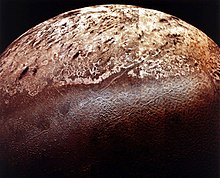
Triton's south polar region is covered by a highly reflective cap of frozen nitrogen and methane sprinkled by impact craters and openings of geysers. Little is known about the north pole because it was on the night side during the Voyager 2 encounter, but it is thought that Triton must also have a north polar ice cap.[50]
The high plains found on Triton's eastern hemisphere, such as Cipango Planum, cover over and blot out older features, and are therefore almost certainly the result of icy lava washing over the previous landscape. The plains are dotted with pits, such as Leviathan Patera, which are probably the vents from which this lava emerged. The composition of the lava is unknown, although a mixture of ammonia and water is suspected.[7]
Four roughly circular "walled plains" have been identified on Triton. They are the flattest regions so far discovered, with a variance in altitude of less than 200 m. They are thought to have formed from the eruption of icy lava.[7] The plains near Triton's eastern limb are dotted with black spots, the maculae. Some maculae are simple dark spots with diffuse boundaries, and others comprise a dark central patch surrounded by a white halo with sharp boundaries. The maculae typically have diameters of about 100 km and widths of the halos of between 20 and 30 km.[7]
There are extensive ridges and valleys in complex patterns across Triton's surface, probably the result of freeze–thaw cycles.[72] Many also appear to be tectonic and may result from an extension or strike-slip faulting.[73] There are long double ridges of ice with central troughs bearing a strong resemblance to Europan lineae (although they have a larger scale[74]), and which may have a similar origin,[7] possibly shear heating from strike-slip motion along faults caused by diurnal tidal stresses experienced before Triton's orbit was fully circularized.[74] These faults with parallel ridges expelled from the interior cross complex terrain with valleys in the equatorial region. The ridges and furrows, or sulci, such as Yasu Sulci, Ho Sulci, and Lo Sulci,[75] are thought to be of intermediate age in Triton's geological history, and in many cases to have formed concurrently. They tend to be clustered in groups or "packets".[73]
Cantaloupe terrain
[edit]
Triton's western hemisphere consists of a strange series of fissures and depressions known as "cantaloupe terrain" because it resembles the skin of a cantaloupe melon. Although it has few craters, it is thought that this is the oldest terrain on Triton.[76] It probably covers much of Triton's western half.[7]
Cantaloupe terrain, which is mostly dirty water ice, is only known to exist on Triton. It contains depressions 30–40 km in diameter.[76] The depressions (cavi) are probably not impact craters because they are all of the similar size and have smooth curves. The leading hypothesis for their formation is diapirism, the rising of "lumps" of less dense material through a stratum of denser material.[7][77] Alternative hypotheses include formation by collapses, or by flooding caused by cryovolcanism.[76]
Impact craters
[edit]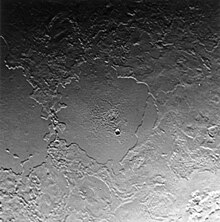
Due to constant erasure and modification by ongoing geological activity, impact craters on Triton's surface are relatively rare. A census of Triton's craters imaged by Voyager 2 found only 179 that were incontestably of impact origin, compared with 835 observed for Uranus's moon Miranda, which has only three percent of Triton's surface area.[78] The largest crater observed on Triton thought to have been created by an impact is a 27-kilometer-diameter (17 mi) feature called Mazomba.[78][79] Although larger craters have been observed, they are generally thought to be volcanic.[78]
The few impact craters on Triton are almost all concentrated in the leading hemisphere—that facing the direction of the orbital motion—with the majority concentrated around the equator between 30° and 70° longitude,[78] resulting from material swept up from orbit around Neptune.[60] Because it orbits with one side permanently facing the planet, astronomers expect that Triton should have fewer impacts on its trailing hemisphere, due to impacts on the leading hemisphere being more frequent and more violent.[78] Voyager 2 imaged only 40% of Triton's surface, so this remains uncertain. However, the observed cratering asymmetry exceeds what can be explained based on the impactor populations, and implies a younger surface age for the crater-free regions (≤ 6 million years old) than for the cratered regions (≤ 50 million years old).[59]
Observation and exploration
[edit]

The orbital properties of Triton were already determined with high accuracy in the 19th century. It was found to have a retrograde orbit, at a very high angle of inclination to the plane of Neptune's orbit. The first detailed observations of Triton were not made until 1930. Little was known about the satellite until Voyager 2 flew by in 1989.[7]
Before the flyby of Voyager 2, astronomers suspected that Triton might have liquid nitrogen seas and a nitrogen/methane atmosphere with a density as much as 30% that of Earth. Like the famous overestimates of the atmospheric density of Mars, this proved incorrect. As with Mars, a denser atmosphere is postulated for its early history.[80]
The first attempt to measure the diameter of Triton was made by Gerard Kuiper in 1954. He obtained a value of 3,800 km. Subsequent measurement attempts arrived at values ranging from 2,500 to 6,000 km, or from slightly smaller than the Moon (3,474.2 km) to nearly half the diameter of Earth.[81] Data from the approach of Voyager 2 to Neptune on August 25, 1989, led to a more accurate estimate of Triton's diameter (2,706 km).[82]
In the 1990s, various observations from Earth were made of the limb of Triton using the occultation of nearby stars, which indicated the presence of an atmosphere and an exotic surface. Observations in late 1997 suggest that Triton is heating up and the atmosphere has become significantly denser since Voyager 2 flew past in 1989.[54]
New concepts for missions to the Neptune system to be conducted in the 2010s were proposed by NASA scientists on numerous occasions over the last decades. All of them identified Triton as being a prime target and a separate Triton lander comparable to the Huygens probe for Titan was frequently included in those plans. No efforts aimed at Neptune and Triton went beyond the proposal phase and NASA's funding for missions to the outer Solar System is currently focused on the Jupiter and Saturn systems.[83] A proposed lander mission to Triton, called Triton Hopper, would mine nitrogen ice from the surface of Triton and process it to be used as a propellant for a small rocket, enabling it to fly or 'hop' across the surface.[84][85] Another concept, involving a flyby, was formally proposed in 2019 as part of NASA's Discovery Program under the name Trident.[86] Neptune Odyssey is a mission concept for a Neptune orbiter with a focus on Triton being studied beginning April 2021 as a possible large strategic science mission by NASA that would launch in 2033 and arrive at the Neptune system in 2049.[87] Two lower-cost mission concepts were subsequently developed for the New Frontiers program: the first the following June and the second in 2023. The first is Triton Ocean World Surveyor, which would launch in 2031 and arrive in 2047,[88] and the second is Nautilus, which would launch August 2042 and arrive in April 2057.[89][16]
Maps
[edit]See also
[edit]- List of natural satellites
- Geology of Triton
- Neptune in fiction § Triton
- Triton Hopper, a proposed lander to Triton
- Triton's sky
- Shensuo, a proposed mission that would flyby Triton
Notes
[edit]- ^ Calculated on the basis of other parameters.
- ^ Surface area derived from the radius r: .
- ^ Volume v derived from the radius r: .
- ^ Surface gravity derived from the mass m, the gravitational constant G and the radius r: .
- ^ Escape velocity derived from the mass m, the gravitational constant G and the radius r: .
- ^ With respect to Triton's orbit about Neptune.
- ^ Lassell rejected his previous claim of discovery when he found that the orientation of the supposed rings changed when he rotated his telescope tube; see p. 9 of Smith & Baum, 1984.[19]
- ^ Largest irregular moons: Saturn's Phoebe (210 km), Uranus's Sycorax (160 km), and Jupiter's Himalia (140 km)
- ^ Mass of Triton: 2.14×1022 kg. Combined mass of 12 other known moons of Neptune: 7.53×1019 kg, or 0.35%. The mass of the rings is negligible.
- ^ The masses of other spherical moons are: Titania—3.5×1021, Oberon—3.1×1021, Rhea—2.3×1021, Iapetus—1.8×1021, Charon—1.6×1021, Ariel—1.2×1021, Umbriel—1.3×1021, Dione—1.1×1021, Tethys—0.6×1021, Enceladus—0.11×1021, Miranda—0.06×1021, Mimas—0.04×1021. The total mass of remaining moons is about 0.12×1021. So, the total mass of all moons smaller than Triton is about 1.68×1022. (See List of Solar System objects by size)
References
[edit]- ^ Robert Graves (1945) Hercules, My Shipmate
- ^ a b c Williams, David R. (November 23, 2006). "Neptunian Satellite Fact Sheet". NASA. Archived from the original on October 20, 2011. Retrieved January 18, 2008.
- ^ a b Overbye, Dennis (November 5, 2014). "Bound for Pluto, Carrying Memories of Triton". New York Times. Retrieved November 5, 2014.
- ^ a b c d e Jacobson, R. A. – AJ (April 3, 2009). "Planetary Satellite Mean Orbital Parameters". JPL satellite ephemeris. JPL (Solar System Dynamics). Archived from the original on October 14, 2011. Retrieved October 26, 2011.
- ^ a b c d e f Jacobson, R. A. (April 3, 2009). "The Orbits of the Neptunian Satellites and the Orientation of the Pole of Neptune". The Astronomical Journal. 137 (5): 4322–4329. Bibcode:2009AJ....137.4322J. doi:10.1088/0004-6256/137/5/4322.
- ^ a b c d e "Planetary Satellite Physical Parameters". JPL (Solar System Dynamics). Archived from the original on August 14, 2009. Retrieved October 26, 2011.
- ^ a b c d e f g h i j k l m n o p q r s t u v McKinnon, William B.; Kirk, Randolph L. (2014). "Triton". In Tilman Spohn; Doris Breuer; Torrence Johnson (eds.). Encyclopedia of the Solar System (3rd ed.). Amsterdam; Boston: Elsevier. pp. 861–882. ISBN 978-0-12-416034-7.
- ^ "Classic Satellites of the Solar System". Observatorio ARVAL. Archived from the original on July 9, 2011. Retrieved September 28, 2007.
- ^ Fischer, Daniel (February 12, 2006). "Kuiperoids & Scattered Objects". Argelander-Institut für Astronomie. Archived from the original on September 26, 2011. Retrieved July 1, 2008.
- ^ Elliot, J.L.; Strobel, D.F.; Zhu, X.; et al. (2000). "The Thermal Structure of Triton's Middle Atmosphere" (PDF). Icarus. 143 (2): 425–428. Bibcode:2000Icar..143..425E. doi:10.1006/icar.1999.6312.
- ^ a b Sicardy, B.; Tej, A.; Gomez-Júnior, A. R.; et al. (February 2024). "Constraints on the evolution of the Triton atmosphere from occultations: 1989-2022". Astronomy & Astrophysics. 682: 8. arXiv:2402.02476. Bibcode:2024A&A...682L..24S. doi:10.1051/0004-6361/202348756.
- ^ a b c Lellouch, E.; de Bergh, C.; Sicardy, B.; Ferron, S.; Käufl, H.-U. (2010). "Detection of CO in Triton's atmosphere and the nature of surface-atmosphere interactions". Astronomy & Astrophysics. 512: L8. arXiv:1003.2866. Bibcode:2010A&A...512L...8L. doi:10.1051/0004-6361/201014339. S2CID 58889896.
- ^ Chang, Kenneth (October 18, 2014). "Dark Spots in Our Knowledge of Neptune". New York Times. Retrieved October 21, 2014.
- ^ a b c d Agnor, C. B.; Hamilton, D. P. (2006). "Neptune's capture of its moon Triton in a binary–planet gravitational encounter" (PDF). Nature. 441 (7090): 192–4. Bibcode:2006Natur.441..192A. doi:10.1038/nature04792. PMID 16688170. S2CID 4420518. Archived from the original (PDF) on October 14, 2016. Retrieved August 28, 2015.
- ^ "NASA Selects Four Possible Missions to Study the Secrets of the Solar System". NASA Jet Propulsion Laboratory (JPL). Retrieved January 16, 2023.
- ^ a b "Planetary Science Summer School · Jason Dekarske". Jason Dekarske. December 19, 2023. Retrieved January 25, 2024.
- ^ a b Lassell, William (November 12, 1847). "Lassell's Satellite of Neptune". Monthly Notices of the Royal Astronomical Society. 10 (1): 8. Bibcode:1847MNRAS...8....9B. doi:10.1093/mnras/10.1.8.
- ^
Lassell, William (November 13, 1846). "Discovery of Supposed Ring and Satellite of Neptune". Monthly Notices of the Royal Astronomical Society. 7 (9): 157. Bibcode:1846MNRAS...7..157L. doi:10.1093/mnras/7.9.154.
Lassell, William (December 11, 1846). "Physical observations on Neptune". Monthly Notices of the Royal Astronomical Society. 7 (10): 167–168. Bibcode:1847MNRAS...7..297L. doi:10.1093/mnras/7.10.165a.
Lassell, W. (1847). "Observations of Neptune and his satellite". Monthly Notices of the Royal Astronomical Society. 7 (17): 307–308. Bibcode:1847MNRAS...7..307L. doi:10.1093/mnras/7.17.307. - ^ a b Smith, R. W.; Baum, R. (1984). "William Lassell and the Ring of Neptune: A Case Study in Instrumental Failure". Journal for the History of Astronomy. 15 (42): 1–17. Bibcode:1984JHA....15....1S. doi:10.1177/002182868401500101. S2CID 116314854.
- ^ a b "The Royal Observatory Greenwich – where east meets west: Telescope: The Lassell 2-foot Reflector (1847)". www.royalobservatorygreenwich.org. Retrieved November 28, 2019.
- ^ Flammarion, Camille (1880). Astronomie populaire. p. 591. Archived from the original on March 1, 2012. Retrieved April 10, 2007.
- ^ Moore, Patrick (April 1996). The planet Neptune: an historical survey before Voyager. Wiley-Praxis Series in Astronomy and Astrophysics (2nd ed.). John Wiley & Sons. pp. 150 (see p. 68). ISBN 978-0-471-96015-7. OCLC 33103787.
- ^ "Planet and Satellite Names and their Discoverers". International Astronomical Union. Archived from the original on February 12, 2008. Retrieved January 13, 2008.
- ^ Davies, M.; Rogers, P.; Colvin, T. (1991). "A Control Network of Triton" (PDF). J. Geophys. Res. 96(E1) (E1): 15675–15681. Bibcode:1991JGR....9615675D. doi:10.1029/91JE00976.
- ^ Seasons Discovered on Neptune's Moon Triton – Space.com (2010) Archived September 17, 2011, at the Wayback Machine
- ^ a b Chyba, C. F.; Jankowski, D. G.; Nicholson, P. D. (July 1989). "Tidal evolution in the Neptune-Triton system". Astronomy and Astrophysics. 219 (1–2): L23 – L26. Bibcode:1989A&A...219L..23C.
- ^ a b Cruikshank, Dale P. (2004). "Triton, Pluto, Centaurs, and Trans-Neptunian Bodies". Space Science Reviews. 116 (1–2): 421–439. Bibcode:2005SSRv..116..421C. doi:10.1007/s11214-005-1964-0. ISBN 978-1-4020-3362-9. S2CID 189794324.
- ^ a b "Pluto and the largest moon of Neptune might be siblings". New Scientist UK edition. June 18, 2024. pp. Space section. Retrieved June 27, 2024.
- ^ Ross, MN; Schubert, G (September 1990). "The coupled orbital and thermal evolution of Triton". Geophysical Research Letters. 17 (10): 1749–1752. Bibcode:1990GeoRL..17.1749R. doi:10.1029/GL017i010p01749.
- ^ Sheppard, Scott S.; Jewitt, David (2004). "Extreme Kuiper Belt Object 2001 QG298 and the Fraction of Contact Binaries". The Astronomical Journal. 127 (5): 3023–3033. arXiv:astro-ph/0402277. Bibcode:2004AJ....127.3023S. doi:10.1086/383558. ISSN 0004-6256. S2CID 119486610.
- ^ Jewitt, Dave (2005). "Binary Kuiper Belt Objects". University of Hawaii. Archived from the original on July 16, 2011. Retrieved June 24, 2007.
- ^ Raluca Rufu and Robin Canup (November 5, 2017). "Triton's evolution with a primordial Neptunian satellite system". The Astronomical Journal. 154 (5): 208. arXiv:1711.01581. Bibcode:2017AJ....154..208R. doi:10.3847/1538-3881/aa9184. PMC 6476549. PMID 31019331.
- ^ "Triton crashed into Neptune's moons". New Scientist. 236 (3152): 16. November 18, 2017. Bibcode:2017NewSc.236...16.. doi:10.1016/S0262-4079(17)32247-9.
- ^ a b "Triton (Voyager)". NASA. June 1, 2005. Archived from the original on September 27, 2011. Retrieved December 9, 2007.
- ^ Ruiz, Javier (December 2003). "Heat flow and depth to a possible internal ocean on Triton" (PDF). Icarus. 166 (2): 436–439. Bibcode:2003Icar..166..436R. doi:10.1016/j.icarus.2003.09.009. Archived from the original (PDF) on December 12, 2019. Retrieved June 25, 2019.
- ^ Medkeff, Jeff (2002). "Lunar Albedo". Sky and Telescope Magazine. Archived from the original on May 23, 2008. Retrieved February 4, 2008.
- ^ "12.3: Titan and Triton". October 7, 2016.
- ^ "Triton: Neptune's Moon". January 2010.
- ^ "Triton – NASA Science". Archived from the original on January 7, 2024. Retrieved January 7, 2024.
- ^ Nelson, R.M.; Smythe, W.D.; Wallis, B.D.; Horn, L.J.; et al. (1990). "Temperature and Thermal Emissivity of the Surface of Neptune's Satellite Triton". Science. 250 (4979): 429–431. Bibcode:1990Sci...250..429N. doi:10.1126/science.250.4979.429. PMID 17793020. S2CID 20022185.
- ^ Grundy, W. M.; Buie, M. W.; Spencer, J. R. (October 2002). "Spectroscopy of Pluto and Triton at 3–4 Microns: Possible Evidence for Wide Distribution of Nonvolatile Solids" (PDF). The Astronomical Journal. 124 (4): 2273–2278. Bibcode:2002AJ....124.2273G. doi:10.1086/342933. S2CID 59040182. Archived from the original (PDF) on February 18, 2019.
- ^ Hussmann, Hauke; Sohl, Frank; Spohn, Tilman (November 2006). "Subsurface oceans and deep interiors of medium-sized outer planet satellites and large trans-neptunian objects". Icarus. 185 (1): 258–273. Bibcode:2006Icar..185..258H. doi:10.1016/j.icarus.2006.06.005.
- ^ a b c Wenz, John (October 4, 2017). "Overlooked Ocean Worlds Fill the Outer Solar System". Scientific American.
- ^ a b Nimmo, Francis (January 15, 2015). "Powering Triton's recent geological activity by obliquity tides: Implications for Pluto geology" (PDF). Icarus. 246: 2–10. Bibcode:2015Icar..246....2N. doi:10.1016/j.icarus.2014.01.044. S2CID 40342189.
- ^ Irwin, L. N.; Schulze-Makuch, D. (2001). "Assessing the Plausibility of Life on Other Worlds". Astrobiology. 1 (2): 143–60. Bibcode:2001AsBio...1..143I. doi:10.1089/153110701753198918. PMID 12467118.
- ^ Doyle, Amanda (September 6, 2012). "Does Neptune's moon Triton have a subsurface ocean?". Space.com. Retrieved September 18, 2015.
- ^ Ingersoll, Andrew P. (1990). "Dynamics of Triton's atmosphere". Nature. 344 (6264): 315–317. Bibcode:1990Natur.344..315I. doi:10.1038/344315a0. S2CID 4250378.
- ^ a b Broadfoot, A. L.; Atreya, S. K.; Bertaux, J. L.; Blamont, J. E.; Dessler, A. J.; Donahue, T. M.; Forrester, W. T.; Hall, D. T.; Herbert, F.; Holberg, J. B.; Hunter, D. M.; Krasnopolsky, V. A.; Linick, S.; Lunine, Jonathan I.; McConnell, J. C.; Moos, H. W.; Sandel, B. R.; Schneider, N. M.; Shemansky, D. E.; Smith, G. R.; Strobel, D. F.; Yelle, R. V. (1989). "Ultraviolet Spectrometer Observations of Neptune and Triton". Science. 246 (4936): 1459–66. Bibcode:1989Sci...246.1459B. doi:10.1126/science.246.4936.1459. PMID 17756000. S2CID 21809358.
- ^ Miller, Ron; Hartmann, William K. (May 2005). The Grand Tour: A Traveler's Guide to the Solar System (3rd ed.). Thailand: Workman Publishing. pp. 172–73. ISBN 978-0-7611-3547-0.
- ^ a b Duxbury, N S; Brown, R H (August 1993). "The Phase Composition of Triton's Polar Caps". Science. 261 (5122): 748–751. Bibcode:1993Sci...261..748D. doi:10.1126/science.261.5122.748. PMID 17757213. S2CID 19761107.
- ^ Tryka, K. A.; Brown, R. H.; Anicich, V.; Cruikshank, D. P.; Owen, T. C. (1993). "Spectroscopic Determination of the Phase Composition and Temperature of Nitrogen Ice on Triton". Science. 261 (5122): 751–4. Bibcode:1993Sci...261..751T. doi:10.1126/science.261.5122.751. PMID 17757214. S2CID 25093997.
- ^ a b Smith, B. A.; Soderblom, L. A.; Banfield, D.; Barnet, C.; Basilevsky, A. T.; Beebe, R. F.; Bollinger, K.; Boyce, J. M.; Brahic, A. (1989). "Voyager 2 at Neptune: Imaging Science Results". Science. 246 (4936): 1422–1449. Bibcode:1989Sci...246.1422S. doi:10.1126/science.246.4936.1422. PMID 17755997. S2CID 45403579.
- ^ Stevens, M. H.; Strobel, D. F.; Summers, M. E.; Yelle, R. V. (April 3, 1992). "On the thermal structure of Triton's thermosphere". Geophysical Research Letters. 19 (7): 669–672. Bibcode:1992GeoRL..19..669S. doi:10.1029/92GL00651. Retrieved October 8, 2011.
- ^ a b Savage, D.; Weaver, D.; Halber, D. (June 24, 1998). "Hubble Space Telescope Helps Find Evidence that Neptune's Largest Moon Is Warming Up". Hubblesite. STScI-1998-23. Archived from the original on May 16, 2008. Retrieved December 31, 2007.
- ^ "MIT researcher finds evidence of global warming on Neptune's largest moon". Massachusetts Institute of Technology. June 24, 1998. Archived from the original on October 16, 2011. Retrieved December 31, 2007.
- ^ MacGrath, Melissa (June 28, 1998). "Solar System Satellites and Summary". Hubble's Science Legacy: Future Optical/Ultraviolet Astronomy from Space. 291. Space Telescope Science Institute: 93. Bibcode:2003ASPC..291...93M.
- ^ Buratti, Bonnie J.; Hicks, Michael D.; Newburn, Ray L. Jr. (January 21, 1999). "Does global warming make Triton blush?". Nature. 397 (6716): 219–20. Bibcode:1999Natur.397..219B. doi:10.1038/16615. PMID 9930696. S2CID 204990689.
- ^ Gray, D (1989). "Voyager 2 Neptune navigation results". Astrodynamics Conference: 108. doi:10.2514/6.1990-2876.
- ^ a b Mah, J.; Brasser, R. (2019). "The origin of the cratering asymmetry on Triton". Monthly Notices of the Royal Astronomical Society. 486: 836–842. arXiv:1904.08073. doi:10.1093/mnras/stz851. S2CID 118682572.
- ^ a b Schenk, Paul M.; Zahnle, Kevin (December 2007). "On the negligible surface age of Triton". Icarus. 192 (1): 135–49. Bibcode:2007Icar..192..135S. doi:10.1016/j.icarus.2007.07.004.
- ^ Williams, Matt (July 28, 2015). "Neptune's Moon Triton". Universe Today. Retrieved September 26, 2017.
- ^ Oleson, Steven R.; Landis, Geoffrey. Triton Hopper: Exploring Neptune's Captured Kuiper Belt Object (PDF). Planetary Science Vision 2050 Workshop 2017.
- ^ Martin-Herrero, Alvaro; Romeo, Ignacio; Ruiz, Javier (2018). "Heat flow in Triton: Implications for heat sources powering recent geologic activity". Planetary and Space Science. 160: 19–25. Bibcode:2018P&SS..160...19M. doi:10.1016/j.pss.2018.03.010. S2CID 125508759.
- ^ Schenk, Paul; Beddingfield, Chloe; Bertrand, Tanguy; et al. (September 2021). "Triton: Topography and Geology of a Probable Ocean World with Comparison to Pluto and Charon". Remote Sensing. 13 (17): 3476. Bibcode:2021RemS...13.3476S. doi:10.3390/rs13173476.
- ^ "Triton's Volcanic Plains". Lunar and Planetary Institute. August 25, 2009.
- ^ Schenk, Paul; Prockter, Louise. "Candidate Cryovolcanic Features in the Outer Solar System" (PDF). Lunar and Planetary Institute.
- ^ Soderblom, L. A.; Kieffer, S. W.; Becker, T. L.; Brown, R. H.; Cook, A. F. II; Hansen, C. J.; Johnson, T. V.; Kirk, R. L.; Shoemaker, E. M. (October 19, 1990). "Triton's Geyser-Like Plumes: Discovery and Basic Characterization" (PDF). Science. 250 (4979): 410–415. Bibcode:1990Sci...250..410S. doi:10.1126/science.250.4979.410. PMID 17793016. S2CID 1948948.
- ^ Kargel, JS (1994). "Cryovolcanism on the icy satellites". Earth, Moon, and Planets. 67 (1–3) (published 1995): 101–113. Bibcode:1995EM&P...67..101K. doi:10.1007/BF00613296. S2CID 54843498.
- ^ USGS Astrogeology Research Program: Gazetteer of Planetary Nomenclature, search for "Hili" and "Mahilani" Archived February 26, 2009, at the Wayback Machine
- ^ a b c Hofgartner, Jason D.; Birch, Samuel P. D.; Castillo, Julie; Grundy, Will M.; Hansen, Candice J.; Hayes, Alexander G.; Howett, Carly J. A.; Hurford, Terry A.; Martin, Emily S.; Mitchell, Karl L.; Nordheim, Tom A.; Poston, Michael J.; Prockter, Louise M.; Quick, Lynnae C.; Schenk, Paul (March 15, 2022). "Hypotheses for Triton's plumes: New analyses and future remote sensing tests". Icarus. 375: 114835. arXiv:2112.04627. Bibcode:2022Icar..37514835H. doi:10.1016/j.icarus.2021.114835. ISSN 0019-1035.
- ^ Burnham, Robert (August 16, 2006). "Gas jet plumes unveil mystery of 'spiders' on Mars". Arizona State University. Archived from the original on October 14, 2013. Retrieved August 29, 2009.
- ^ Elliot, J. L.; Hammel, H. B.; Wasserman, L. H.; Franz, O. G.; McDonald, S. W.; Person, M. J.; Olkin, C. B.; Dunham, E. W.; Spencer, J. R.; Stansberry, J. A.; Buie, M. W.; Pasachoff, J. M.; Babcock, B. A.; McConnochie, T. H. (1998). "Global warming on Triton". Nature. 393 (6687): 765–767. Bibcode:1998Natur.393..765E. doi:10.1038/31651. S2CID 40865426.
- ^ a b Collins, Geoffrey; Schenk, Paul (March 14–18, 1994). Triton's Lineaments: Complex Morphology and Stress Patterns. Abstracts of the 25th Lunar and Planetary Science Conference. Abstracts of the 25th Lunar and Planetary Science Conference. Vol. 25. Houston, TX. p. 277. Bibcode:1994LPI....25..277C.
- ^ a b Prockter, L. M.; Nimmo, F.; Pappalardo, R. T. (July 30, 2005). "A shear heating origin for ridges on Triton" (PDF). Geophysical Research Letters. 32 (14): L14202. Bibcode:2005GeoRL..3214202P. doi:10.1029/2005GL022832. S2CID 8623816. Retrieved October 9, 2011.
- ^ Aksnes, K; Brahic, A; Fulchignoni, M; Marov, M Ya (1990). "Working Group for Planetary System Nomenclature" (PDF). Reports on Astronomy. 21A. State University of New York (published 1991): 613–19. 1991IAUTA..21..613A. Retrieved January 25, 2008.
- ^ a b c Boyce, Joseph M. (March 1993). "A structural origin for the cantaloupe terrain of Triton". In Lunar and Planetary Inst., Twenty-fourth Lunar and Planetary Science Conference. Part 1: A-F (SEE N94-12015 01-91). 24: 165–66. Bibcode:1993LPI....24..165B.
- ^ Schenk, P.; Jackson, M. P. A. (April 1993). "Diapirism on Triton: A record of crustal layering and instability". Geology. 21 (4): 299–302. Bibcode:1993Geo....21..299S. doi:10.1130/0091-7613(1993)021<0299:DOTARO>2.3.CO;2.
- ^ a b c d e Strom, Robert G.; Croft, Steven K.; Boyce, Joseph M. (1990). "The Impact Cratering Record on Triton". Science. 250 (4979): 437–39. Bibcode:1990Sci...250..437S. doi:10.1126/science.250.4979.437. PMID 17793023. S2CID 38689872.
- ^ Ingersoll, Andrew P.; Tryka, Kimberly A. (1990). "Triton's Plumes: The Dust Devil Hypothesis". Science. 250 (4979): 435–437. Bibcode:1990Sci...250..435I. doi:10.1126/science.250.4979.435. PMID 17793022. S2CID 24279680.
- ^ Lunine, Jonathan I.; Nolan, Michael C. (November 1992). "A massive early atmosphere on Triton". Icarus. 100 (1): 221–34. Bibcode:1992Icar..100..221L. doi:10.1016/0019-1035(92)90031-2.
- ^ Cruikshank, D. P.; Stockton, A.; Dyck, H. M.; Becklin, E. E.; Macy, W. (1979). "The diameter and reflectance of Triton". Icarus. 40 (1): 104–114. Bibcode:1979Icar...40..104C. doi:10.1016/0019-1035(79)90057-5.
- ^ Stone, EC; Miner, ED (December 15, 1989). "The Voyager 2 Encounter with the Neptunian System". Science. 246 (4936): 1417–21. Bibcode:1989Sci...246.1417S. doi:10.1126/science.246.4936.1417. PMID 17755996. S2CID 9367553. And the following 12 articles pp. 1422–1501.
- ^ "USA.gov: The U.S. Government's Official Web Portal" (PDF). Nasa.gov. September 27, 2013. Archived from the original (PDF) on October 25, 2012. Retrieved October 10, 2013.
- ^ Ferreira, Becky (August 28, 2015). "Why We Should Use This Jumping Robot to Explore Neptune". Vice Motherboard. Retrieved March 20, 2019.
- ^ Oleson, Steven (May 7, 2015). "Triton Hopper: Exploring Neptune's Captured Kuiper Belt Object". NASA Glenn Research Center. Retrieved February 11, 2017.
- ^ Brown, David W. (March 19, 2019). "Neptune's Moon Triton Is Destination of Proposed NASA Mission". The New York Times. Retrieved March 20, 2019.
- ^ Abigail Rymer; Brenda Clyde; Kirby Runyon (August 2020). "Neptune Odyssey: Mission to the Neptune-Triton System" (PDF). Archived from the original (PDF) on December 15, 2020. Retrieved April 18, 2021.
- ^ Hansen-Koharcheck, Candice; Fielhauer, Karl (June 7, 2021). "Triton Ocean Worlds Surveyor concept study" (PDF). NASA.
- ^ Steckel, Amanda; Conrad, Jack William; Dekarske, Jason; Dolan, Sydney; Downey, Brynna Grace; Felton, Ryan; Hanson, Lavender Elle; Giesche, Alena; Horvath, Tyler; Maxwell, Rachel; Shumway, Andrew O; Siddique, Anamika; Strom, Caleb; Teece, Bronwyn; Todd, Jessica; Trinh, Kevin T; Velez, Michael A; Walter, Callum Andrew; Lowes, Leslie L; Hudson, Troy; Scully, Jennifer E. C. (December 12, 2023). "The Science Case for Nautilus: A Multi-Flyby Mission Concept to Triton". AGU - Agu23. AGU. Retrieved January 11, 2024.
External links
[edit]- Triton profile at NASA's Solar System Exploration site
- Voyager 2 Encounters Neptune and Triton (1989) on YouTube
- Triton page at The Nine Planets
- Triton page (including labelled Triton map) at Views of the Solar System
- Triton map from Paul Schenk, Lunar and Planetary Institute
- Triton images from the NASA/JPL Photojournal
- Triton nomenclature from the USGS Planetary Nomenclature website
 KSF
KSF


